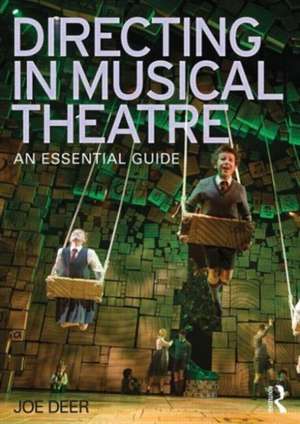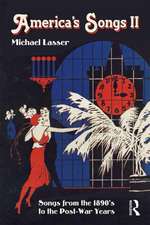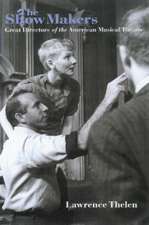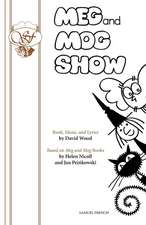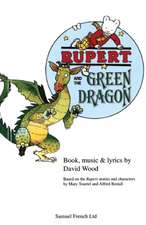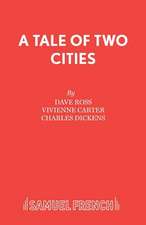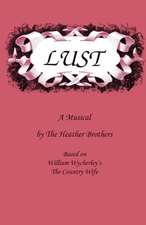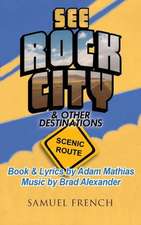Directing in Musical Theatre: An Essential Guide
Autor Joe Deeren Limba Engleză Paperback – 23 dec 2013
Deer’s accessible and compellingly practical approach uses proven, repeatable methods for addressing all aspects of a production. The focus at every stage is on working with others, using insights from experienced, successful directors to tackle common problems and devise solutions. Each section uses the same structure, to stimulate creative thinking:
- Timetables: detailed instructions on what to do and when, to provide a flexible organization template
- Prompts and Investigations: addressing conceptual questions about style, characterization and design
- Skills Workshops: Exercises and ‘how-to’ guides to essential skills
- Essential Forms and Formats: Including staging notation, script annotation and rehearsal checklists
- Case Studies: Well-known productions show how to apply each chapter’s ideas
| Toate formatele și edițiile | Preț | Express |
|---|---|---|
| Paperback (1) | 311.90 lei 3-5 săpt. | +24.44 lei 7-13 zile |
| Taylor & Francis – 23 dec 2013 | 311.90 lei 3-5 săpt. | +24.44 lei 7-13 zile |
| Hardback (1) | 768.46 lei 6-8 săpt. | |
| Taylor & Francis – 23 dec 2013 | 768.46 lei 6-8 săpt. |
Preț: 311.90 lei
Nou
59.68€ • 62.31$ • 49.39£
Carte disponibilă
Livrare economică 15-29 martie
Livrare express 01-07 martie pentru 34.43 lei
Specificații
ISBN-10: 0415624908
Pagini: 288
Ilustrații: 7 black & white illustrations, 27 colour illustrations, 1 black & white line drawings, 6 colour line drawings
Dimensiuni: 174 x 246 x 15 mm
Greutate: 0.5 kg
Ediția:1
Editura: Taylor & Francis
Colecția Routledge
Locul publicării:Oxford, United Kingdom
Cuprins
Table of Contents
Foreword by Eric Schaeffer
Introduction
How To Use This Book
Phase One: Conception
Timetable One: Preparation
Chapter One: Preparing for Collaboration
Unit 1.1 Reading and listening to the Musical
Unit 1.1.1 Gathering Impressions
Questionnaire: First Impressions
Unit 1.2 Creating a Research Portfolio
Unit 1.3 History and Society Viewed Selectively
Unit 1.4 Tradition
Unit 1.5 Dissecting the Script and Score
Unit 1.5.1 Units of Action
Questionnaire: Unit Analysis
Unit 1.6 Character Analysis
Unit 1.6.1 Facts
Questionnaire: Character Given Circumstances
Unit 1.6.2 Character Journey
Unit 1.6.3 Charting Change
Unit 1.6.4 Attitudes
Questionnaire: Character Attitudes
Unit 1.6.5 Ambitions
Questionnaire: Character Ambitions
Unit 1.7 Directing and Style
Unit 1.7.1 What Is Style?
Unit 1.7.2 Establishing Style in Your Production
Unit 1.7.3 Unity of Style
Unit 1.7.4 History and Genre
Unit 1.7.5 Worldview
Questionnaire: Defining Worldview
Unit 1.7.5 Articulating Style
Questionnaire: Elements of Style
Unit 1.8 Visiting the Performance Space
Unit 1.9 Getting It Down On Paper - Creating a Concept Statement
Unit 1.9.1 This Is The Story Of …
Unit 1.9.2 Themes and Ideas
Unit 1.9.3 Images and Visual Style
Unit 1.9.4 State Your Passion
Chapter Two: Imagining The Chorus
Unit 2.1 What is a chorus?
Unit 2.2 Populating the world of your musical
Unit 2.3 The power of the group
Unit 2.4 Applying Pressure
Unit 2.5 Chorus as Storyteller
Unit 2.6 Chorus as Spectacle
Unit 2.7 Chorus as Characters
Unit 2.8 Engaging Chorus Actors
Phase Two: Collaboration
Timetable: Phase Two
Chapter Three: Creative Collaboration
Unit 3.1 The Passionate Center
Unit 3.2 What is a Choreographer?
Unit 3.3 Theatre Dance vs. Concert Dance
Unit 3.4 Musical Collaboration
Chapter Four: Directing the Design
Unit 4.1 Design Process: Scenery
Unit 4.1.1 Scenic Design Preparation
Questionnaire: Scenic Design
Unit 4.1.2 What to Expect in the Scenic Design Process
Scenic Design Process for Big River
Unit 4.2 Design Process: Costumes
Unit 4.2.1 Character Analysis for Costume Design
Unit 4.2.2 Practical Requirements
Unit 4.2.3 Cast by Scene Breakdown
Unit 4.2.4 What to Expect in the Costume Design Process
Gregg Barnes’ Costume Design Process for The Drowsy Chaperone
Unit 4.3 Design Process: Lighting
Unit 4.3.1 What to Expect in the Lighting Design Process
Natasha Katz’ Lighting Design Process for Follies
Unit 4.4 Budgets and Creative Limits
Checklist: Effective Design
Phase Three: Rehearsal
Timetable Three: Auditions to Final Studio Run-Through
Chapter Five: Auditions
Unit 5.1 Casting Breakdowns
Unit 5.2 Principal Role Auditions
Unit 5.3 Chorus Calls
Unit 5.4 Addressing Multiple Casting Needs
Unit 5.5 Non-Traditional Casting
Unit 5.6 Negotiations and Waiting
Chapter Six: Staging and Coaching
Unit 6.1 Staging Stories
Unit 6.1.1 Levels of Staging
Unit 6.1.2 Staging Questions
Questionnaire: Staging Action
Unit 6.1.3 Believable Spontaneity and Inevitability
Unit 6.1.4 Types of Musical Numbers
Unit 6.1.5 Prompts to Staging Opportunities
Unit 6.1.6 Staging Structure
Unit 6.1.7 Storytelling Through Staging
Unit 6.1.8 All Staging is Action
Unit 6.1.9 Storytelling ߝ Beat-by-beat
Unit 6.1.10 Group Staging Notation
‘I Wanna Be A Producer’ from The Producers
Unit 6.1.11 Choreographic Staging
Unit 6.2 Staging Tools
Unit 6.2.1 Movement and Images
Unit 6.2.2 Principles of Effective Blocking
Unit 6.2.3 Compositional Qualities
Unit 6.3 Blocking Scenes and Songs
Unit 6.3.1 Blocking Script Set Up
Next to Normal scene/song blocking script
Unit 6.3.2 Ideas Into Action
Unit 6.3.3 Blocking Notation
Unit 6.3.4 Giving Blocking to Actors
Unit 6.4 Coaching Your Cast
Unit 6.4.1 Actor/Singers
Unit 6.4.2 10 Keys to Coaching the Singing Actor
Unit 6.4.3 Dancers are actors, too
Unit 6.5 Entertainment Values and ‘Selling It’ To The Audience
Phase Four: Production
Timetable: Phase Four
Chapter Seven: Moving Into The Theatre
Unit 7.1 Getting acquainted with the space
Unit 7.2 Spacing Rehearsals and Adjustments
Unit 7.3 Safety First
Unit 7.4 Adding Scenery and Props
Unit 7.5 Adding Lighting
Unit 7.6 Adding Orchestra
Unit 7.7 Sound Design and Reinforcement
Unit 7.8 The Stage Manager Takes Charge ߝ Technical Rehearsal
Unit 7.9 Adding Costumes
Unit 7.10 Crew
Unit 7.11 Special Rehearsals
Unit 7.12 Putting It All Back Together
Unit 7.13 Finding The Heart of the show again
Unit 7.14 Prioritizing and Problem Solving
Unit 7.15 "Please" and "Thank You"
Phase Five: Performance
Timetable: Previews to Closing
Chapter Eight: Shaping the Production
Unit 8.1 Curtain Calls
Unit 8.2 Previews
Unit 8.3 Advice and Opinions
Unit 8.4 Opening Night
Unit 8.5 Notes and Rehearsal After Opening
Unit 8.6 Post Mortem
Chapter Nine: Etcetera ߝ And All The Rest
Unit 9.1 Directing New Works
Unit 9.2 Directing Revues
Unit 9.3 Habits of Successful Directors
Appendices
Appendix A: Sample Documents
- Weekly Rehearsal Schedule ߝ Seussical
- Daily Rehearsal Schedule ߝ Carousel
- Blocking/Staging Checklist ߝ Seussical
- Cast-by-scene Breakdowns ߝ Nine
- Scene and Song Rehearsal Unit Breakdown ߝ Kiss Me, Kate
- Concept Statement ߝ Into The Woods
- Scene/Song Unit Analysis ߝ Fiddler On The Roof
- Character Analysis (short) ߝ The Light In The Piazza
- Staging Roadmap (Beat Breakdown) ߝ ‘The Night Waltz’ from A Little Night Music
Appendix B: Complete Production Timetable
Appendix C: Blank Questionnaires
- First Impressions
- Unit Analysis
- Character Given Circumstances
- Character Attitudes
- Character Ambitions
- Defining Worldview
- Elements of Style
- Scenic Design
- Staging Action
- Checklist: Effective Design
Appendix D: A Brief Glossary of Useful Stage Terms
Recenzii
'Directing is a somewhat ‘ethereal’ job ߝ those who do not do it have a hard time articulating what it is we exactly do as Directors. I think this book is both practical, but asks the right questions so that directors do not merely ‘replicate’ another show.' ߝ David Gram, Director, Dramaturg, Actor & Teacher, USA
'Finally! A step-by-step handbook on how to direct musicals. Joe Deer’s Directing In Musical Theatre is the perfect book for aspiring and experienced directors alike. The craft of directing can be quite mysterious, but as Joe masterfully tells it, with thoughtful insight, extraordinary detail and great passion, the director’s role becomes vividly clear. This book is sure to become a valuable resource for anyone working in the theatre.' ߝ Marcia Milgrom Dodge, Tony Award Nominated Director & Choreographer, RAGTIME
'A terrific analysis of how to mount a musical. From reading the script, right up to opening night, Joe Deer's insights are practical and inspiring.' ߝ Walter Bobbie, Tony Award winning Director, CHICAGO
'Joe Deer's book is an eloquent and accurate analysis of what a director in the musical theatre actually does. He understands the many components of a musical and how to coordinate and integrate them. I highly recommend it to anyone contemplating directing a musical.' ߝ Jerry Zaks, Tony Award winning Director, GUYS AND DOLLS and SMOKEY JOE’S CAFÉ
'Directing In Musical Theatre is a splendid text for anyone wishing to explore directing for the musical stage. It deals with every essential aspect of this daunting task, and explains each with singular clarity and intelligence. The work is well organized, thorough, and completely accessible. Finally, here is a book that gets to the heart of this art.' ߝ Gregory Lehane, Professor - Former Head of Directing, Drama and Music, Carnegie Mellon University
'Joe Deer's Directing in the Musical Theatre is a well-informed exploration of the musical theatre directing process that is filled with heart, intellect and spirit. If every director was required to read the chapter on staging alone, we would be blessed with productions more truthful, entertaining, and ultimately satisfying. This book, which equally balances craft with artistry, will be helpful to beginner and seasoned veteran alike.' ߝ Cary Libkin, Professor, Head Of Musical Theatre Degree Programs, Penn State University
Notă biografică
Joe Deer is Distinguished Professor of Musical Theatre and Director of The Musical Theatre Initiative at Wright State University. He has directed off-Broadway, in top regional theatres across the US and at many of the finest educational institutions in the world. His first book, Acting in Musical Theatre: a comprehensive course (co-author, Rocco Dal Vera) is also available from Routledge.
Descriere
This comprehensive guide, from the author of Acting in Musical Theatre, will equip aspiring directors with all of the skills that they will need in order to guide a production from beginning to end. From the very first conception and collaborations with crew and cast, through rehearsals and technical production all the way to the final performance, Joe Deer covers the full range.
Deer’s accessible and compellingly practical approach uses proven, repeatable methods for addressing all aspects of a production. The focus at every stage is on working with others, using insights from experienced, successful directors to tackle common problems and devise solutions. Each section uses the same structure, to stimulate creative thinking:
- Timetables: detailed instructions on what to do and when, to provide a flexible organization template
- Prompts and Investigations: addressing conceptual questions about style, characterization and design
- Skills Workshops: Exercises and ‘how-to’ guides to essential skills
- Essential Forms and Formats: Including staging notation, script annotation and rehearsal checklists
- Case Studies: Well-known productions show how to apply each chapter’s ideas
Directing in Musical Theatre not only provides all of the essential skills, but explains when and how to put them to use; how to think like a director.
